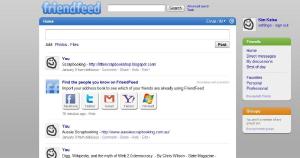Not to be confused with the term Internet Footprint is this week’s topic, the Digital Shadow. Unlike your Internet Footprint which is achieved as the result of a user’s conscious and intentional contribution of content to the Internet, your Digital Shadow is a reflection of how visible you are in the online world and can often result from the actions of other users. Mostly, this visibility is determined by search engines.
Using various search engines to determine my digital shadow I was pleased to see that my high privacy settings have done a good job and, other than one study blog, I was largely invisible. It’s not that I have anything to hide online as such, it’s just that I don’t particularly have anything that I feel the need to share with the world at large either. I’m pleased that typing in my name doesn’t result in photos and writings jumping out at me… hopefully it means that nothing is jumping out at other Internet users as well.
The first featured reading by danah boyd, Facebook’s Privacy Trainwreck : Exposure, Invasion, and Social Convergence explores the implications of Facebook’s implementation of it’s News Feed feature and the subsequent outcry about user privacy resulting in massive changes to the privacy settings of the social network. What some see as social convergence many saw as a frightening shift in the boundaries of privacy and expression. When every action a person makes online is visible to every single one of his/her friends, where are the boundaries and what are the possible repercussions? These are the questions that boyd seeks answers to in her paper. Ultimately, boyd concludes that ‘privacy is not an inalienable right – it is a privilege that must be protected socially and structurally in order to exist. The question remains as to whether or not privacy is something that society wishes to support’. From this we can take the meaning that it is up to individuals to take charge of their own privacy and also choose carefully which platforms foster their required privacy choices.
The second reading is Daniel Solove’s The Future of Reputation: Gossip, Rumour, and Privacy on the Internet. This writing takes focus on how the Internet has changed the flow of information and communication in a myriad of ways and how these changes have affected society’s perception of privacy. Solove covers in some depth the increasing prevalence of blogging, personal websites and social networking directing our thought to how we use these platforms to share information with others. He makes a particularly valid point in commenting that ‘given the ease at which information can be recorded and spread, there will be more instances when information we want to keep on a short leash will escape from our control’. He goes on to illustrate his point by reminding readers of such issues as emails or text messages accidentally sent to wrong recipients, blogs read by those the author hoped would never see them and images or videos, at times of a very personal nature, posted online by others out to cause hurt to those involved. The article concludes by saying that whilst we live in a time of wondrous communication and expression, with that power comes vulnerability and vigilance is ever necessary. The price of our using the Internet is that we be aware of the way in which we allow ourselves to be seen and the power we give others over our material. As history has shown many times before, with great power and freedom comes great responsibility, and this is definitely that case in the online world.
Lastly, Coutu and boyd discuss the issue of Mimi, a prospective employee with a dubious online presence. The case study discuss whether Mimi should be hired for a particular after a google search found articles relating to her and protests that she has been involved in. Her digital shadow raises concerns that detract from the question of her ability to perform the job involved. boyd raises good points in her contention that many young people have an online presence and that it is precisely this that illustrates Mimi’s creativity – the most valuable asset required for the position in question. In my opinion, Mimi should absolutely get the job.
Likewise, Claire Werbeloff made quite a name for herself on Australian television and computer screens. Honestly, I am unsure how I would respond to her as an employer. Certainly, she has shown that she has quite an imagination and some acting skills (if only as portraying a ‘bogan’). Perhaps if I required these skills she would fit the mould, otherwise my interpretation of her is that of a lying attention seeker – not something I would hope for in my business.


